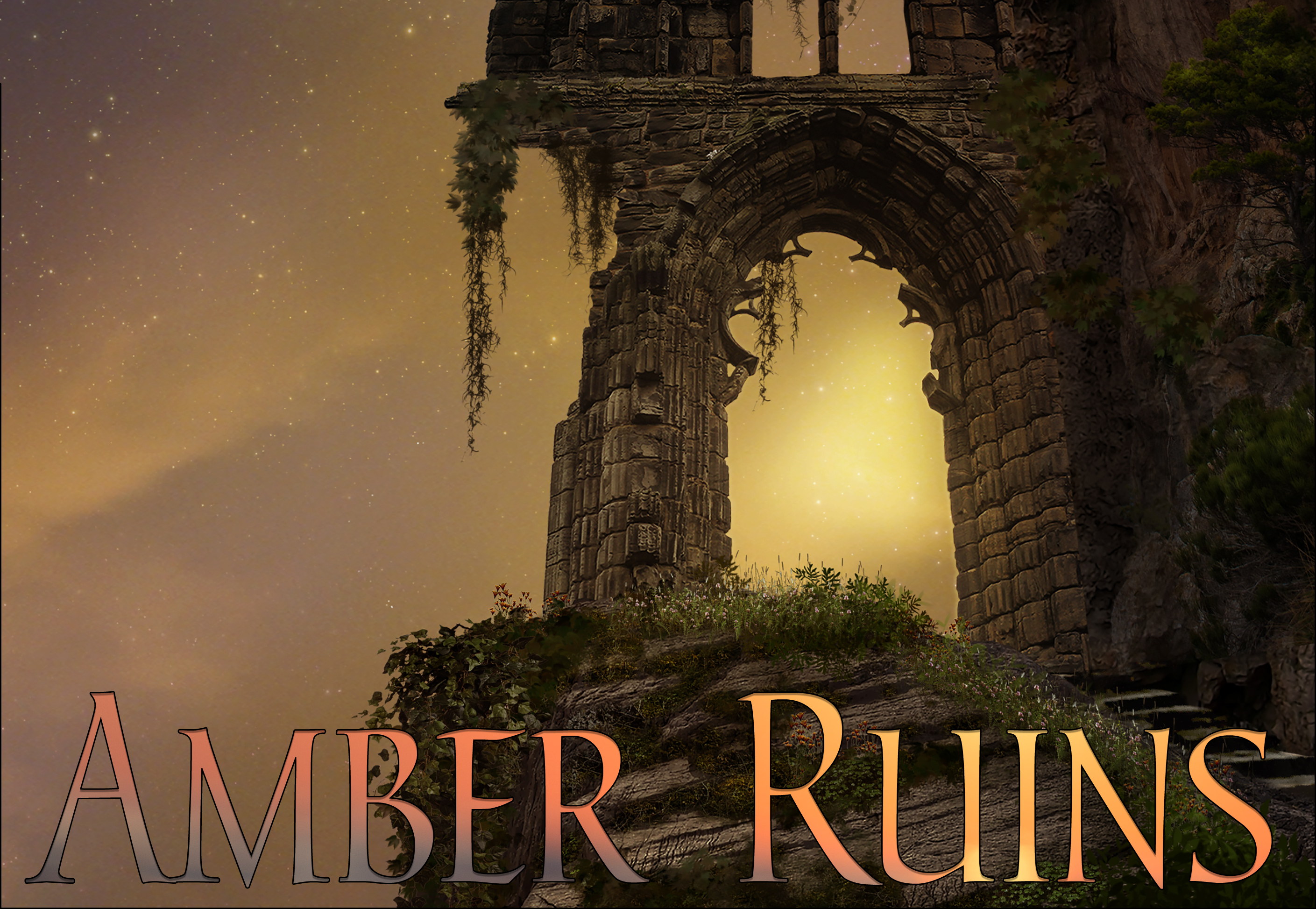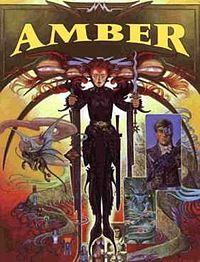
This campaign concept was created in 1998 for a PBeM Amber Diceless Roleplaying Game campaign that, sadly like so many other PBeM campaigns, was rather abortive and terminated after just a couple of moves (as a result of players not responding). It notably features a rather novel interpretation of the metaphysics of the Amber universe.
If you aren’t familiar with Roger Zelazny’s Amber novels, I heartily recommend them. The First Chronicles (comprising the first five volumes) are particularly excellent.
The main characters are the six children of Elder Amberites. Their actual creation shall be left up to the players – who they are, where they have been living, how long do they think they’ve been alive, etc. — but they are the children of:
- Corwin
- Benedict
- Merlin (with Julia)
- Eric
- Fiona
- Flora (with a Shadow Earth lover)
These six characters do not understand their place in the multiverse —as far as they know, the world in which they live is the only one which exists. Most of the characters will know that there is something special about them, if no other reason than because they do not seem to age normally (assuming they exist in shadows where time runs either similar to or quicker than Amber).
Shadows in this multiverse are limited to technology levels comparable to the modern day. (No science fiction concepts.) This may not be wholly true to Zelazny’s description of “anything can be found in Shadow,” but is true to the spirit and atmosphere of the books themselves.
BACKGROUND
Two hundred years ago in Amber, strange behavior began to manifest within shadow. Shadow storms increased in regularity, odd bursts of primal chaos began causing havoc, shadows flickered in and out of reality — even the areas closest to Amber were disrupted. An entire kingdom of the Golden Circle was wiped out in a massive burst of primal chaos. Although Fiona of Amber and Mandor of Chaos had been investigating the odd phenomena from the beginning, it became of imminent importance to all Amberites when a shadow storm broke loose within the Forest of Arden itself.
What was unknown to them was that a fifth-dimensional force — which we’ll call Entropy — was making its influence felt.
To understand this, one must first understand that Amber, the Courts of Chaos, and each individual shadow consists of three spatial dimension and one temporal dimension. Travelling from shadow to shadow is to travel through the fourth spatial dimension. So the entire span from Amber to Chaos — and the shadows between — encompasses a fourth-dimensional space construct with Amber at one “end” and the Courts at the other. The Abyss is the hole at the Chaos end of things where the fourth-dimensional construct comes to an end.
This entire fourth-dimensional construct exists within a higher-dimensional reality. And it is the not the only such construct. Entropy controls another of these constructs, which has drifted through hyper-dimensional space until coming into contact with the Amber-Chaos construct. Once it came into contact with Amber-Chaos, Entropy attached itself and began an attempt to subjugate the powers already found there.
In fact, by the time Amber became aware of the troubles in shadow, Entropy and its agents had already been active for some time. Among other things, Dworkin and Suhuy had been taken out of the equation by their Entropic counterpart Aerist. Eventually, however, efforts by Corwin, Benedict, Jurt, and Fiona succeeded in unravelling the mystery of what was happening. A coalition between the forces of Chaos and Amber succeeded in sealing the Amber-Chaos construct by erecting the Barrier. They did this, however, knowing that their effort in raising the Barrier would result in the two royal families being drawn into a stasis bubble trapped between the two constructs of Amber-Chaos and Entropy. This also placed the Pattern and Logrus into a form of stasis.
They left behind them six children of Amber. Too young to even remember Amber and not yet aligned with the Pattern, the children were not drawn into stasis. It was hoped that some day they might find a final solution to the incursion of Entropy.
ENTROPY
Entropy is a primal force defining the Entropy construct in the same that Order and Chaos define the Amber-Chaos construct. When Chaos emerged as the Great Serpent and Order, later, emerged as the Unicorn, the force of Entropy emerged as the Entropic Dragon. Where the Serpent saw to the construction of the Logrus through its agent Suhuy and the Unicorn to the construction of the Pattern through Dworkin, Entropy created the Entropic Cone through its agent, Aerist.
The Entropic Cone is a hollow cone which is entered from its broad base. The brave soul who does so is bathed and purified in primal entropic forces and eventually emerges from the tip of the cone with powers somewhat similar to those who emerge from the Pattern and Logrus.
The Men in Black who will come to haunt the PCs are the agents of Entropy who infiltrated the Amber-Construct. When the Barrier was erected they were sealed off from the Entropic Cone and lost their powers, but as the Barrier begins to disintegrate the MIB will regain their powers.
LIFE
Entropy once shared its construct with the balancing force of Life, which emerged in the form of the Phoenix and used a rogue agent of Entropy to construct the Life Spiral. For awhile their construct was similar to the balance of the Amber-Chaos construct — two poles with a host of shadow between them created by the tension and conflict between them. At some point in the past, however, the force of Life was betrayed and lost in its fight with Entropy. Entropy now dominates and completely controls the construct, and a static nothingness has been the result.
Anyone who has read this type of stuff before will likely realize that one possible solution to the current problems will be gained not by trying to destroy the Entropic force, but by rekindling the still burning embers of the Life force and restoring balance to the alien multiverse.
THE BARRIER
The Barrier is located all along the “edge” shadows, as well as in Amber and the Courts of Chaos. It seals the Amber-Chaos construct from the Entropy construct.
The Barrier is invisible in Amber (where it narrows to a point) and is a huge white curtain of scintillating energy which seals the Courts from where the Abyss once stood. Along its length in shadow, however, are a great variety of local “interpretations” of the Barrier (much like the local interpretations of the Black Road in the First Chronicles). For example, in a medieval shadow, a Great Wall may have been constructed beyond which hordes of black demons attempt to invade the land.
THE CAMPAIGN
Initiation. First, the young Amberites must learn their true heritage and their place in the multiverse. They’ve grown up ignorant of shadow, Amber, Chaos, Pattern, Logrus, and Trump. All they (likely) know is that they are different from others — they never age or die.
There are several ways in which these characters can be hooked towards Amber:
- The Unicorn or Great Serpent. Although the Entropic Dragon has succeeded in rendering them effectively powerless, these patrons of Amber and Chaos will be able to communicate mysteriously with the PCs.
- MIB Attack. Men in Black can attempt to attack someone who existence they have discovered. After the entropic agents have been dispatched, PCs can discover a trump they’re carrying which will lead them bewilderingly through shadow.
- Bill Roth. Corwin’s old friend and ally still lives, having taken refuge in slow-moving shadows. He is hardened from many escapes from MIBs. He was entrusted with the duties of contacting the Amberites he knows of (Corwin’s child, Merlin’s child, and Fiona’s child)… he’s just running a little late.
Revive the Pattern & Logrus. Once initiation to the ways of the shadows has been accomplished and the PCs have been drawn together, stage two begins. Roth probably gets himself assassinated around this time, but he does leave the Amberites with the knowledge that they must seek out the Jewel of Judgment (which can be used to reactivate the Pattern).
The Jewel has been hidden in a sanctuary between shadows by Dworkin. Finding it probably means playing along with a mad Dworkin (who, unlike Suhuy, managed to survive Aerist’s attempt on his life).
Aerist. Speaking of Aerist, the Sage of Entropy is our arch-villain. He was within the Amber-Chaos contruct when the Barrier was raised and was driven insane and powerless by his separation from the Entropic Cone. However, with the Barrier beginning to falter his faculties have returned and he wants the Jewel, too.
Destroying the Barrier. The Barrier is already collapsing, but the PCs need to bring it down in a controlled fashion if anything is to be salvaged. (If not, all the Amberites and Chaosites will be lost when the Barrier collapses, along with any hope of re-erecting it.)
The Barrier was “nailed” in place using the nine spikards. One is located in Amber (at the center of the Pattern) and the other in Chaos (within the Logrus), but the other seven must be sought along the edges of shadow… which, of course, are the most dangerous places to be as the breaches in the Barrier begin to increase and the number of MIBs begins to skyrocket.
Editor’s Note: When I first conceived this campaign, this whole section would have been a rather banal, linear “hunt the plot coupon” thing. I didn’t have the tools to do any better. Now you can imagine a seven-way Race to the Prize with all kinds of crazy shenanigans. As a PBeM campaign, Amber Ruins was actually designed with the idea in mind that the players could easily split and pursue individual agendas (although they wouldn’t necessarily have to).
The Big Conclusion. The nine spikards will need to be brought to the Pattern, the Logrus, and Corwin’s Pattern simultaneously for the Barrier to be brought down. At this point the Amberites and Chaosites will reappear and the old alliance will be reborn.
… but it’s not like they’ve had any grand new insights as a result of being held in stasis for two hundred years. The only option the Elders can think of is to raise the Barrier again. But if they do, this time the PCs, too, will be drawn into stasis. And it’s not like the Barrier held last time.
But maybe that’s the best that can be done: New scions must be born in shadow, loyal agents selected from among the friends and allies the PCs have made who (like Bill Roth before them) will watch and wait for the appointed hour. And then all shall pass into stasis in order to preserve the many worlds of shadow for another century or three.
Alternatively, perhaps the PCs will have learned more than the Elders knew. One option would be to invade the Entropic construct and reactivate the Life force (a portion of the story not yet fully comprehended and/or planned, but I’m sure I’ll think of something eventually). Or perhaps they’ll come up with some clever idea of their own.

 Amber: The Diceless Role-Playing Game
Amber: The Diceless Role-Playing Game









